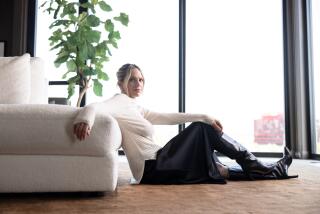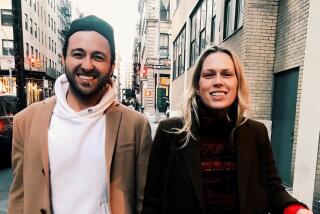Trials of a Convert
In 1985, Nan Fink knew exactly what she wanted: She had undergone a profound religious awakening and was ready to convert to Judaism. But Judaism was less than ready to accept her.
Fink, a Bay Area teacher, psychotherapist and ex-wife of a Protestant minister, knew that Jewish tradition called for a rabbi to turn away potential converts three times to test their resolve. But she wasn’t ready to be shunned, talked about and repeatedly discouraged, not only by rabbis, but by members of the Jewish community.
Despite the obstacles, Fink persevered and became a Jew, as well as co-founding and publishing Tikkun, an influential Jewish magazine. She chronicles her conversion experiences, both bitter and sweet, in a new book, “Stranger in the Midst: A Memoir of Spiritual Discovery” (Basic Books).
She encountered obstacles from the beginning. No one would speak to her at the Orthodox shul she attended with her lover, Michael Lerner, a Jewish intellectual whom she married in 1987. Fink said she was regarded as an interloper because Lerner had broken off a relationship with a woman in the congregation. An anonymous letter told Fink she didn’t belong at the shul. Then a woman took her aside after services.
“Nobody wants you here,” she told Fink. “You’re not welcome.”
The campaign, Fink says, even extended to the Conservative rabbi who agreed to instruct Fink in the faith. He received harassing phone calls in the middle of the night, telling him not to convert her.
While Fink was “trying to birth myself as a Jew,” she and Lerner were also co-founding Tikkun, a bimonthly Jewish critique of politics, culture and society. Until 1990, Fink was the magazine’s publisher, and her work immersed her in Jewish life.
*
Fink said her attraction to Judaism was strong, rooted in a childhood connection to the divine, a love of her Christian church’s liturgy--but not of Jesus, who “never, ever” resonated for her--a respect and love for Jewish values and a desire to be part of a people.
“I had no question but that the people was Judaism,” she said.
Conversion to Judaism “is harder than any faith I know about.” Fink said. Her book points out a number of historical reasons for this. But part of the difficulty is that Judaism isn’t just a religion.
“There’s an ethnic change too,” she said. “If a person becomes a Christian, they’re not challenged on that. It’s a matter of christening, or baptizing.”
But Judaism is a culture too, and when a non-Jew tries to adopt it, “there’s a layer of distrust that exists,” she said.
Fink actually underwent two formal conversions: first in the Conservative branch of the faith and then, just before her marriage to Lerner, in an Orthodox ceremony. (Fink wasn’t enthusiastic about the Orthodox conversions but said she thought it might help her “feel more legitimate” as a Jew. And, she writes, if she ever moved to Israel, strict religious laws at the time recognized only Orthodox conversions.)
But even her second immersion in the mikveh, a ritual bath ceremony that marks a convert’s rebirth as a Jew, didn’t put her at ease in the Jewish world. Converts, she soon found, often hid their non-Jewish pasts with a sense of shame, and Fink found herself doing the same thing.
Rabbi Alan Kalinsky, West Coast Director of the Union of Orthodox Jewish Congregations, said not all converts go through what Fink did.
“There are many people who have come to Judaism in my 12 years in Los Angeles, and they’ve come through the doors of various Orthodox synagogues and have been welcomed with open arms,” he said, adding that the decision to convert must not be done hastily, such as right before marriage to a Jew, but “because it was true faith.”
Fink said other converts she has talked to since the book’s publication have recounted similar difficulties. “In a way, I was expecting to hear, ‘My experience wasn’t like that,’ either that it wasn’t so hard or that I got something wrong,” she said. “I’m not getting any of that.”
Fitting in within the Jewish community wasn’t Fink’s only challenge. Her Christian family--her mother and her three grown children--reacted to her conversion with varying degrees of ambivalence and unease. Fink’s mother invited her kosher-keeping daughter to Easter dinner with the joyous announcement, “We’re having honey-baked ham,” and was hurt when she did not stay for dinner.
Jews by birth questioned the depth of Fink’s faith, assuming she had converted because of her relationship and marriage to Lerner. When the couple divorced in 1990, many assumed it would be the end of Fink’s affiliation with Judaism. They were wrong, and Fink considers the often-made assumption that people convert only because of a mate “very diminishing.”
As a Jew, Fink felt the bite of anti-Semitism firsthand. She discovered a less malevolent but still uncomfortable sentiment: Jewish chauvinism. When Jews joked around her about the stupidity of the “goyim,” Fink pictured them deriding her Christian children. She said the patriarchy of the religion, particularly in Orthodox Judaism, also began to grate.
But by exploring the faith, particularly the realm of Jewish mysticism and meditation, Fink found her place.
Today Fink, 57, co-directs Chochmat HaLev (“Wisdom of the Heart”), a center for Jewish meditation based in Berkeley.
As she travels to promote “Stranger in the Midst,” Fink said converts whisper the secret of their non-Jewish pasts in her ear, and thank her for discussing her experiences.
“I hope in the book that the message comes through that it was really, really worth it,” she said. “I would do it all over again--it’s my life path. So, coming from that point of view, I also wanted to talk about the hard things. I had a little bit of concern that people would just hear the hard things and not hear the other part--how wonderful it is, and how I feel well-situated in the Jewish world. It’s my world.”
That means it’s her world to sometimes criticize and challenge--its patriarchy, chauvinism and Israel’s relationship with the Palestinians. Converts are usually given to understand that they shouldn’t “rock the boat,” with such notions, she said.
“For me, it was a big step in claiming my full membership in the Jewish world to allow myself to challenge those things,” she said.
In her book, Fink describes the moments before her immersion into the mikveh. One member of the Beit Din, the court that questioned her to be sure she understood Judaism, asked her what the faith meant to her. Tears streaming from her eyes, Fink answered, “Everything.”
And now?
“I still answer it the same way: everything,” she said. “The Jewish world is my world my spiritual path. This is my people. Crossing over, becoming a Jew, I consider that the most significant thing I’ve done in my life. That word--everything--still is there.”
More to Read
Sign up for our Book Club newsletter
Get the latest news, events and more from the Los Angeles Times Book Club, and help us get L.A. reading and talking.
You may occasionally receive promotional content from the Los Angeles Times.






